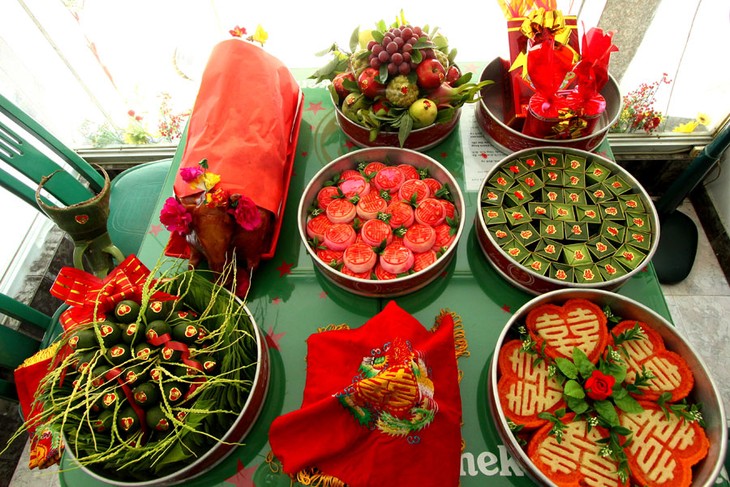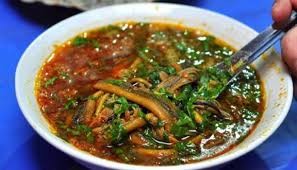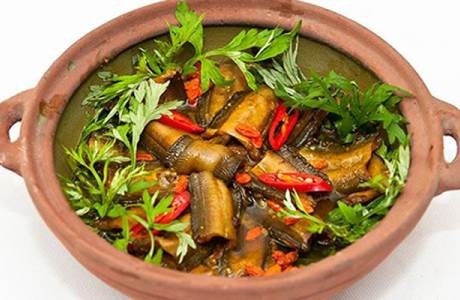A: First on our show today, we’d like to welcome back Risto Happonen of Finland. It has been a long time since we last received feedback from you.
B: In a letter reporting his reception of a VOV broadcast on June 20 from 16:00 to 16:27 on the frequency of 7280, Mr. Happonen also sent us a beautiful postcard of Kuopio city in Finland. Mr. Happonen wrote that he is very interested in stories about Vietnam’s economy, lifestyles, history, culture, and tourist destination and particularly like the Letter Box segment.
A: Thank you, Mr. Happonen, for your feedback. We’ll send you a QSL card to confirm your report.
B: This week we received a postcard from Vo Nhan of Germany. He wrote: “I have just heard a wonderful program about the wedding ritual of the ethnic Dao people of Vietnam. So far, this is the best program I have heard and I also love the song Ho Quynh Huong sang after the news about those days when we were young and went to school. Thank you, VOV.”
 Lacquered boxes containing betrothal presents are prepared on engagement day Lacquered boxes containing betrothal presents are prepared on engagement day |
A: Thank you, Vo Nhan, for your comment and for the beautiful postcard. Like Vo Nhan, Karuna Kanta Pal of India expressed his interest in Vietnamese wedding rituals and asked about the traditional Vietnamese marriage ceremony.
B:: The traditional Vietnamese wedding is one of the most important ceremonies in Vietnamese culture with influences from Confucian and Buddhist ideology. It is a significant day not only for the couple involved but for their entire families and it usually includes quite a few formal ritual observances.
A: Getting married involves various steps and procedures which vary between different ethnic groups and regions, but in general, there are two main ceremonies: the engagement and the wedding ceremony.
B: According to the customs of the Kinh majority people, the bride and groom or their parents go to a fortuneteller to find out what date and time is best for the wedding. They strongly believe in this date and time so the groom's family and relatives must come to the wedding on time.
A: On the engagement day, some days before the wedding, they visit the bride and her family carrying round lacquered boxes containing betrothal presents which consist of areca nuts and betel leaves, tea, cake, fruits, wines and other delicacies covered with a red cloth and carried by unmarried young people.
B: On the wedding day, the groom's family and relatives return to the bride's house. The women dress in traditional long dresses. Men wear suits or traditional gowns. The procession is usually led by the wealthiest, most successful couple in the groom’s family to symbolize their hopes and wishes for the future life of the new couple.
A: The groom's family stops in front of the bride's house to allow the leading couple to enter the house first with a tray of wine. They invite the bride's parents to take a sip. By accepting the toast, the bride's family agrees to let the groom’s family enter their house.
B: The groom's family introduce themselves and ask permission for their son to marry the bride. The master of the ceremony, usually a respected person among the bride's relatives, instructs the bride's parents to present their daughter. The bride in her wedding gown then follows her parents out, followed by her bride maids. The couple pray before an altar and ask their ancestors to bless their marriage, then express their gratitude to their parents for raising and protecting them.
A: Then they bow their head to each other to show their gratitude and respect for their soon-to-be husband or wife. The master of the ceremony gives the wedding couple some advice on starting a new family. The parents take turns sharing their own experience and giving their blessing. After that, the groom and the bride exchange wedding rings and receive gifts from their parents, such as gold bracelets, ear rings, necklaces or other jewelry. The ceremony ends with a round of applause.
B: When the wedding ceremony is over, there is a party at the groom's house or in a restaurant. This day is the culmination of many wishes, day dreams, hopes and anxieties. Guests are free to take the stage and sing a song to wish luck to the bride and groom.
A: Next is a letter from Toda Takeshi of Japan. In his letter, he reported listening to our broadcast on June 23rd from 11:30 to 11:58 UTC on the frequency of 12020 khz. He wrote: “Every summer in Japan, there is “Doyo Ushinohi” day when people eat eels. It is said that we will enjoy good health if we eat eels on this day. In Japan, we bake eels with a sauce made of dark soy sauce, sugar, and sake. This is a dish called “Kabayashi”. Eel in Japan is very expensive. Recently, eel from Vietnam is being sold in Japan. How do you cook eel in Vietnam?”
 Eel soup is one of Nghe An's specialties Eel soup is one of Nghe An's specialties |
B: Mr. Takeshi, it’s interesting to hear about Doyo Ushinohi day and Kabayashi in Japan. In Vietnam, we don’t have such a tradition, but eel is a popular dish in Vietnam, especially in Nghe An province.
A: Nghe An’s eel soup is unforgettable. Thanks to its distinct aromatic flavor, eel soup has been a famous specialty of Nghe An province for a long time. Cooking eel soup is not difficult. Eels are cleaned, boiled and boned. If you use a piece of bamboo instead of a knife to cut up the eel and an earthen pot to cook the eel rather than a copper pan, eel soup will not be ‘fishy’.
 Eel soup is one of Nghe An's specialties Eel soup is one of Nghe An's specialties |
B: People stir-fry eel and saffron, and then add a little chili powder and pepper. The yellow saffron mixed with green onion is attractive to the eye.
A: When cooking eel soup, locals use ordinary rice and add to it a little sticky rice so that the soup is more viscid. They simmer the rice without grinding it as people in other areas do. In summer, when beads of sweat are standing out on your forehead, you should enjoy a hot bowl of eel soup and follow it with a cup of green tea. In winter, add ginger to your cup of green tea to make it warmer. Nghe An eel soup is worth a try. If you visit Vietnam, don’t miss it.
B: This week, we’d like to acknowledge letters and emails form Heimer Sia of the Philippines, Dillipkumar Sarkar, Siddhartha Bhattacharjee, Nitu Kumar, Karobi Hazarika, Madhab Chandra Sagour, Ratan Kumar Paul, Shyamal Kumar Banerjee, and Jayanta Chakrabarty of India, Mizanur Rahaman, Diradul Iqbal of Bangladesh, Sumoto Huang of Indonesia, Peter Ng and Timm Breyel of Malaysia, and Richard Nowak of the US. We’ll send you all QSL cards to confirm your reception reports.
A: We welcome your feedback at English Section, VOVworld, Voice of Vietnam, 45 Ba Trieu Street, Hanoi, Vietnam. Our email address is englishsection@vov.org.vn. Thank you for listening to VOV on shortwave and following us online. Good bye until next time.